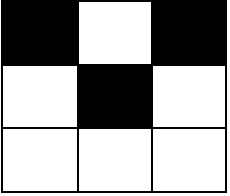


题目描述
给你两个整数 m 和 n ,表示一个下标从 0 开始的 m x n 的网格图。
给你一个下标从 0 开始的二维整数矩阵 coordinates ,其中 coordinates[i] = [x, y] 表示坐标为 [x, y] 的格子是 黑色的 ,所有没出现在 coordinates 中的格子都是 白色的。
一个块定义为网格图中 2 x 2 的一个子矩阵。更正式的,对于左上角格子为 [x, y] 的块,其中 0 <= x < m - 1 且 0 <= y < n - 1 ,包含坐标为 [x, y] ,[x + 1, y] ,[x, y + 1] 和 [x + 1, y + 1] 的格子。
请你返回一个下标从 0 开始长度为 5 的整数数组 arr ,arr[i] 表示恰好包含 i 个 黑色 格子的块的数目。
示例 1:
输入:m = 3, n = 3, coordinates = [[0,0]]
输出:[3,1,0,0,0]
解释:网格图如下:
 只有 1 个块有一个黑色格子,这个块是左上角为 [0,0] 的块。
其他 3 个左上角分别为 [0,1] ,[1,0] 和 [1,1] 的块都有 0 个黑格子。
所以我们返回 [3,1,0,0,0] 。
只有 1 个块有一个黑色格子,这个块是左上角为 [0,0] 的块。
其他 3 个左上角分别为 [0,1] ,[1,0] 和 [1,1] 的块都有 0 个黑格子。
所以我们返回 [3,1,0,0,0] 。
示例 2:
输入:m = 3, n = 3, coordinates = [[0,0],[1,1],[0,2]]
输出:[0,2,2,0,0]
解释:网格图如下:
 有 2 个块有 2 个黑色格子(左上角格子分别为 [0,0] 和 [0,1])。
左上角为 [1,0] 和 [1,1] 的两个块,都有 1 个黑格子。
所以我们返回 [0,2,2,0,0] 。
有 2 个块有 2 个黑色格子(左上角格子分别为 [0,0] 和 [0,1])。
左上角为 [1,0] 和 [1,1] 的两个块,都有 1 个黑格子。
所以我们返回 [0,2,2,0,0] 。
提示:
2 <= m <= 1052 <= n <= 1050 <= coordinates.length <= 104coordinates[i].length == 20 <= coordinates[i][0] < m0 <= coordinates[i][1] < ncoordinates 中的坐标对两两互不相同。
解法
方法一:哈希表计数
对于每个 \(2 \times 2\) 的子矩阵,我们可以用其左上角的坐标 \((x, y)\) 来表示它。
而对于每个黑格子 \((x, y)\),它对 \(4\) 个子矩阵的贡献为 \(1\),即矩阵 \((x - 1, y - 1)\), \((x - 1, y)\), \((x, y - 1)\), \((x, y)\)。
因此,我们遍历所有的黑格子,然后累计每个子矩阵中黑格子的个数,记录在哈希表 \(cnt\) 中。
最后,我们遍历 \(cnt\) 中的所有值(大于 \(0\)),统计其出现的次数,记录在答案数组 \(ans\) 中,而 \(ans[0]\) 则表示没有黑格子的子矩阵的个数,值为 \((m - 1) \times (n - 1) - \sum_{i = 1}^4 ans[i]\)。
时间复杂度 \(O(l)\),空间复杂度 \(O(l)\),其中 \(l\) 为 \(coordinates\) 的长度。
1
2
3
4
5
6
7
8
9
10
11
12
13
14
15 | class Solution:
def countBlackBlocks(
self, m: int, n: int, coordinates: List[List[int]]
) -> List[int]:
cnt = Counter()
for x, y in coordinates:
for a, b in pairwise((0, 0, -1, -1, 0)):
i, j = x + a, y + b
if 0 <= i < m - 1 and 0 <= j < n - 1:
cnt[(i, j)] += 1
ans = [0] * 5
for x in cnt.values():
ans[x] += 1
ans[0] = (m - 1) * (n - 1) - len(cnt.values())
return ans
|
1
2
3
4
5
6
7
8
9
10
11
12
13
14
15
16
17
18
19
20
21
22 | class Solution {
public long[] countBlackBlocks(int m, int n, int[][] coordinates) {
Map<Long, Integer> cnt = new HashMap<>(coordinates.length);
int[] dirs = {0, 0, -1, -1, 0};
for (var e : coordinates) {
int x = e[0], y = e[1];
for (int k = 0; k < 4; ++k) {
int i = x + dirs[k], j = y + dirs[k + 1];
if (i >= 0 && i < m - 1 && j >= 0 && j < n - 1) {
cnt.merge(1L * i * n + j, 1, Integer::sum);
}
}
}
long[] ans = new long[5];
ans[0] = (m - 1L) * (n - 1);
for (int x : cnt.values()) {
++ans[x];
--ans[0];
}
return ans;
}
}
|
1
2
3
4
5
6
7
8
9
10
11
12
13
14
15
16
17
18
19
20
21
22
23 | class Solution {
public:
vector<long long> countBlackBlocks(int m, int n, vector<vector<int>>& coordinates) {
unordered_map<long long, int> cnt;
int dirs[5] = {0, 0, -1, -1, 0};
for (auto& e : coordinates) {
int x = e[0], y = e[1];
for (int k = 0; k < 4; ++k) {
int i = x + dirs[k], j = y + dirs[k + 1];
if (i >= 0 && i < m - 1 && j >= 0 && j < n - 1) {
++cnt[1LL * i * n + j];
}
}
}
vector<long long> ans(5);
ans[0] = (m - 1LL) * (n - 1);
for (auto& [_, x] : cnt) {
++ans[x];
--ans[0];
}
return ans;
}
};
|
1
2
3
4
5
6
7
8
9
10
11
12
13
14
15
16
17
18
19
20 | func countBlackBlocks(m int, n int, coordinates [][]int) []int64 {
cnt := map[int64]int{}
dirs := [5]int{0, 0, -1, -1, 0}
for _, e := range coordinates {
x, y := e[0], e[1]
for k := 0; k < 4; k++ {
i, j := x+dirs[k], y+dirs[k+1]
if i >= 0 && i < m-1 && j >= 0 && j < n-1 {
cnt[int64(i*n+j)]++
}
}
}
ans := make([]int64, 5)
ans[0] = int64((m - 1) * (n - 1))
for _, x := range cnt {
ans[x]++
ans[0]--
}
return ans
}
|
1
2
3
4
5
6
7
8
9
10
11
12
13
14
15
16
17
18
19
20 | function countBlackBlocks(m: number, n: number, coordinates: number[][]): number[] {
const cnt: Map<number, number> = new Map();
const dirs: number[] = [0, 0, -1, -1, 0];
for (const [x, y] of coordinates) {
for (let k = 0; k < 4; ++k) {
const [i, j] = [x + dirs[k], y + dirs[k + 1]];
if (i >= 0 && i < m - 1 && j >= 0 && j < n - 1) {
const key = i * n + j;
cnt.set(key, (cnt.get(key) || 0) + 1);
}
}
}
const ans: number[] = Array(5).fill(0);
ans[0] = (m - 1) * (n - 1);
for (const [_, x] of cnt) {
++ans[x];
--ans[0];
}
return ans;
}
|
只有 1 个块有一个黑色格子,这个块是左上角为 [0,0] 的块。 其他 3 个左上角分别为 [0,1] ,[1,0] 和 [1,1] 的块都有 0 个黑格子。 所以我们返回 [3,1,0,0,0] 。
有 2 个块有 2 个黑色格子(左上角格子分别为 [0,0] 和 [0,1])。 左上角为 [1,0] 和 [1,1] 的两个块,都有 1 个黑格子。 所以我们返回 [0,2,2,0,0] 。


